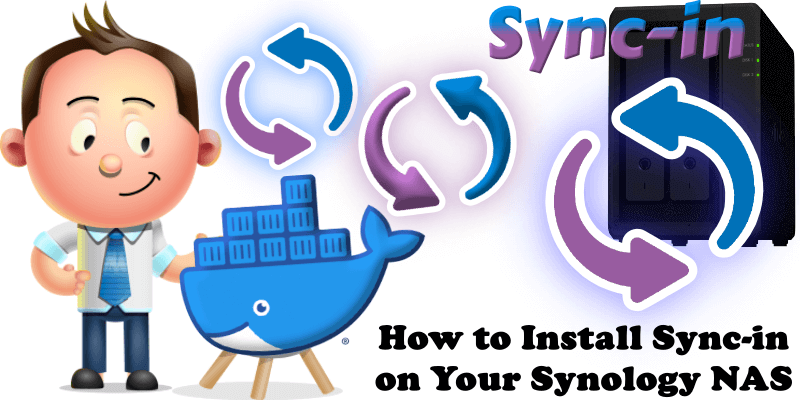
Sync-in is a secure, open-source platform for file storage, sharing, collaboration, and synchronization, giving users full data control through self-hosted infrastructure. It ensures privacy with no tracking or telemetry and offers granular permission management for users and groups at space and file levels. The platform supports cross-device synchronization with native desktop clients for Windows, macOS, and Linux, real-time collaborative document editing via OnlyOffice integration, and organized, secure spaces for personal, team, or public use. Files can be shared with specific users, groups, or via time-limited public links. It includes server-side full-text indexing for fast content search, activity history with notifications, and WebDAV support to mount spaces as remote drives. In this step by step guide I will show you how to install Sync-in on your Synology NAS using Docker & Portainer.
This guide works perfectly with the latest Sync-in v1.8.1 release.
STEP 1
Please Support My work by Making a Donation.
STEP 2
Install Portainer using my step by step guide. If you already have Portainer installed on your Synology NAS, skip this STEP. Attention: Make sure you have installed the latest Portainer version.
STEP 3
Install Text Editor via Synology “Package Center”. (Mandatory STEP.) If you already have Text Editor installed on your Synology NAS, skip this STEP.
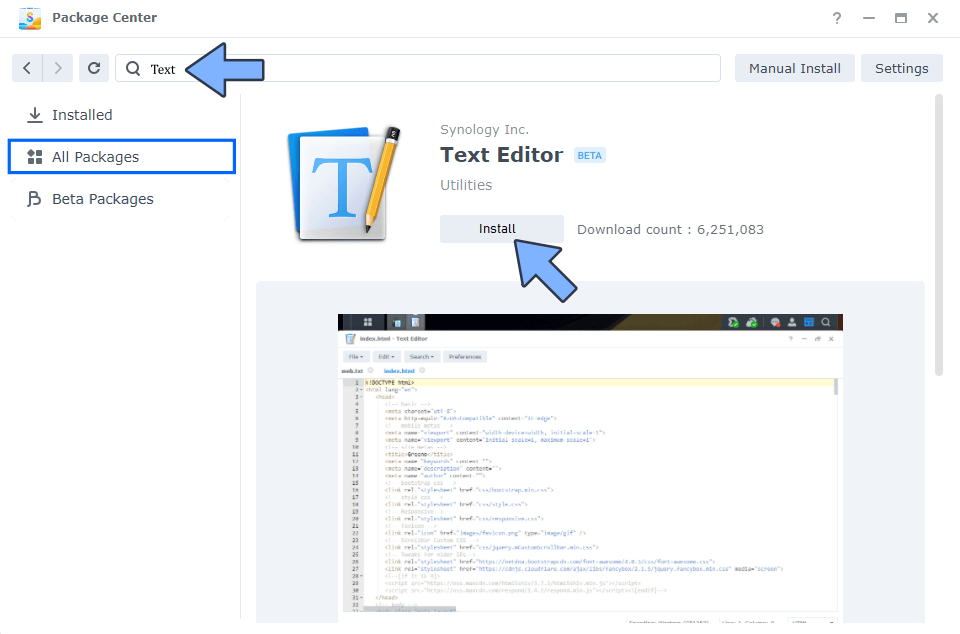
STEP 4
Make sure you have a synology.me Wildcard Certificate. Follow my guide to get a Wildcard Certificate. If you already have a synology.me Wildcard certificate, skip this STEP.
STEP 5
Go to Control Panel / Network / Connectivity / Check Enable HTTP/2 then click Apply. Follow the instructions in the image below.
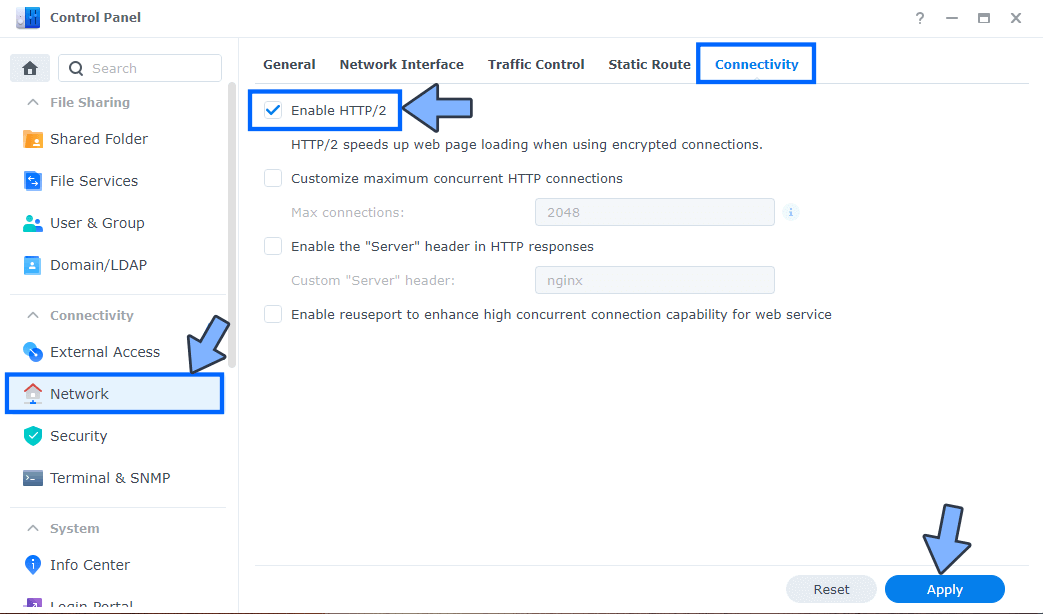
STEP 6
Go to Control Panel / Security / Advanced tab/ Check Enable HTTP Compression then click Apply. Follow the instructions in the image below.
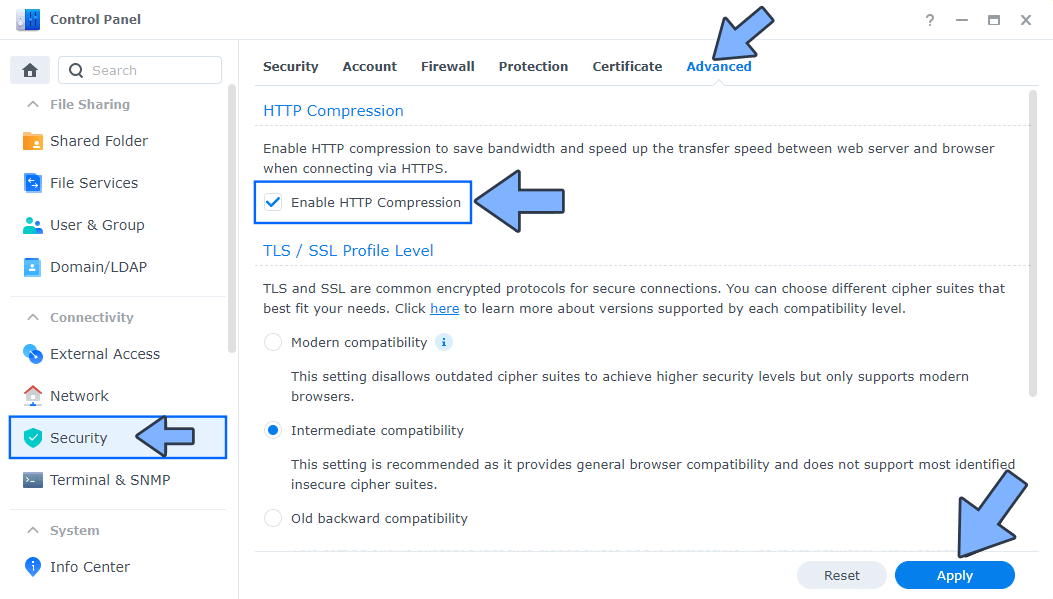
STEP 7
Go to Control Panel / Login Portal / Advanced Tab / click Reverse Proxy. Follow the instructions in the image below.
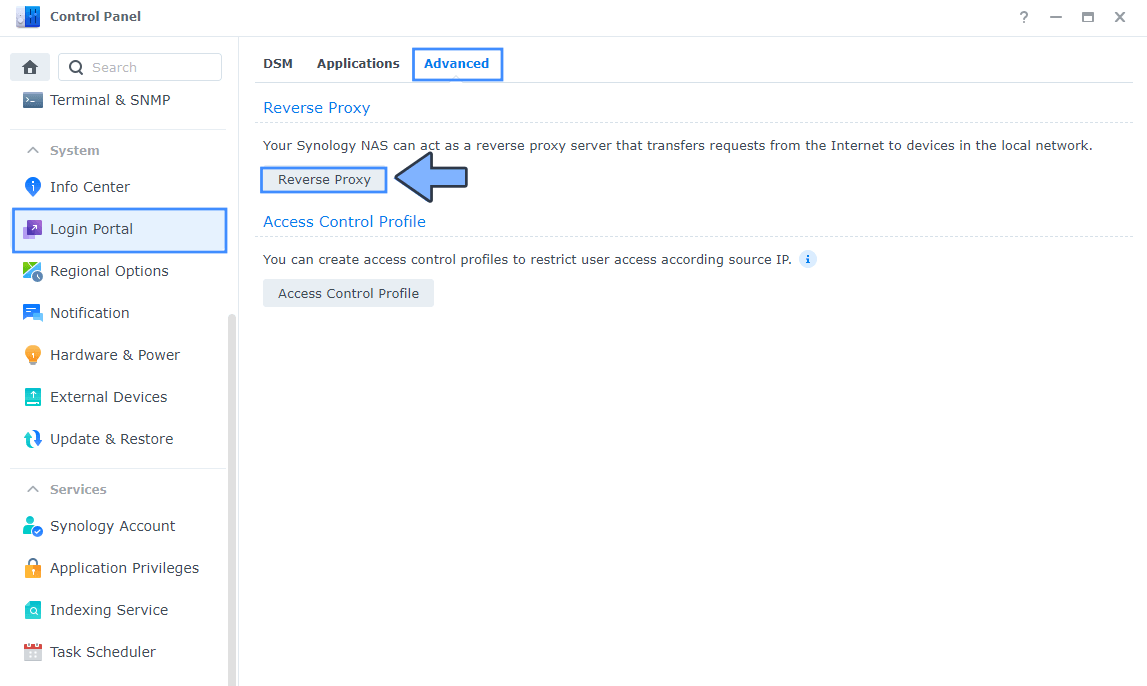
STEP 8
Now click the “Create” button. Follow the instructions in the image below.
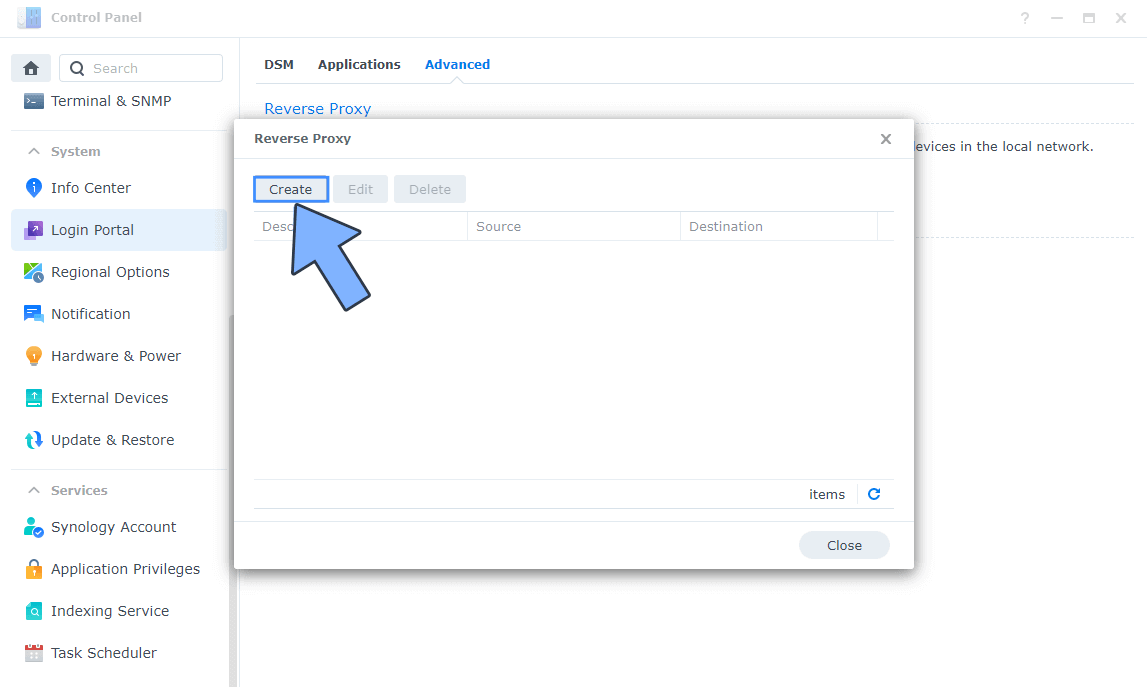
STEP 9
After you click the Create button, the window below will open. Follow the instructions in the image below.
On the General area, set the Reverse Proxy Name description: type in Sync-in. After that, add the following instructions:
Source:
Protocol: HTTPS
Hostname: syncin.yourname.synology.me
Port: 443
Check Enable HSTS
Destination:
Protocol: HTTP
Hostname: localhost
Port: 8324
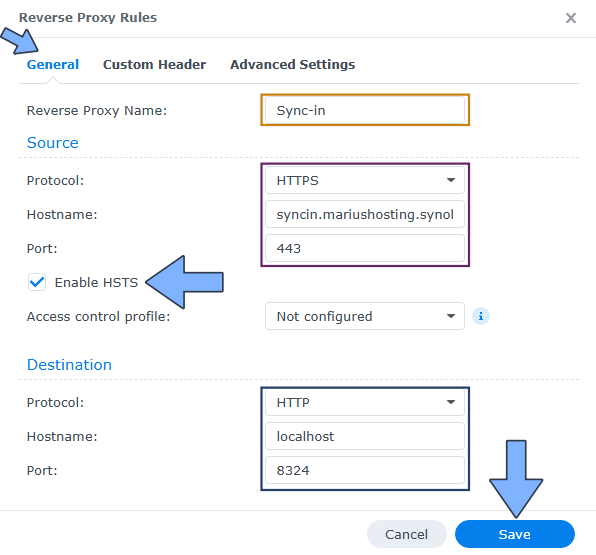
STEP 10
Go to Control Panel / Login Portal / Advanced Tab / click Reverse Proxy. Follow the instructions in the image below.
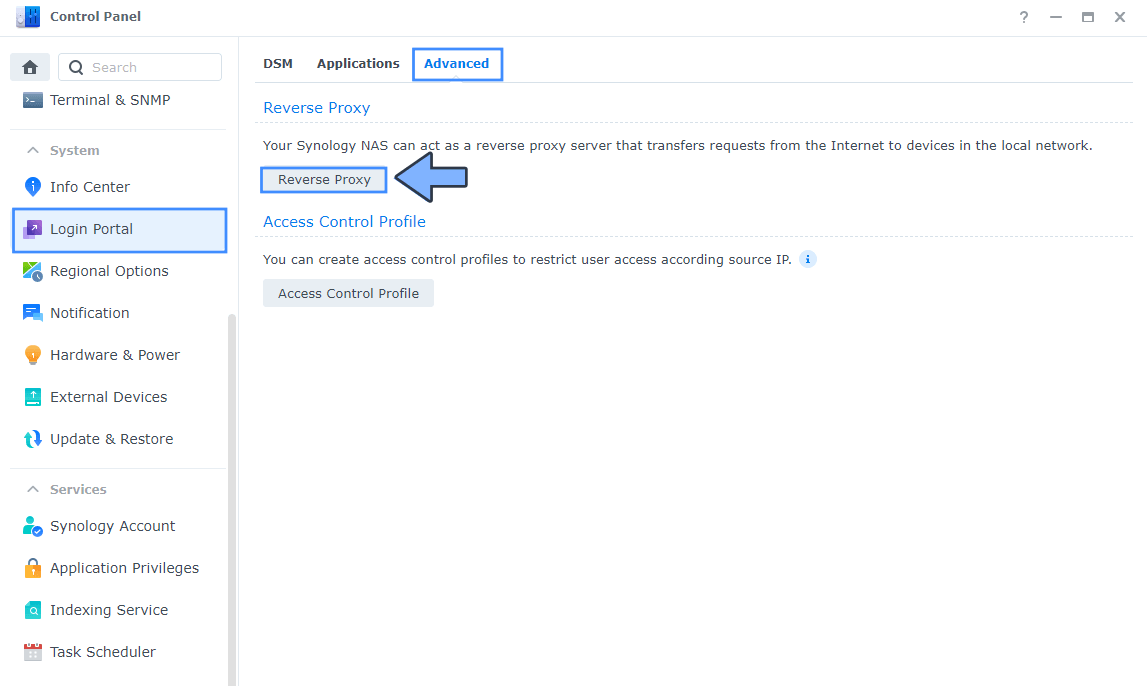
STEP 11
Now click the “Create” button. Follow the instructions in the image below.
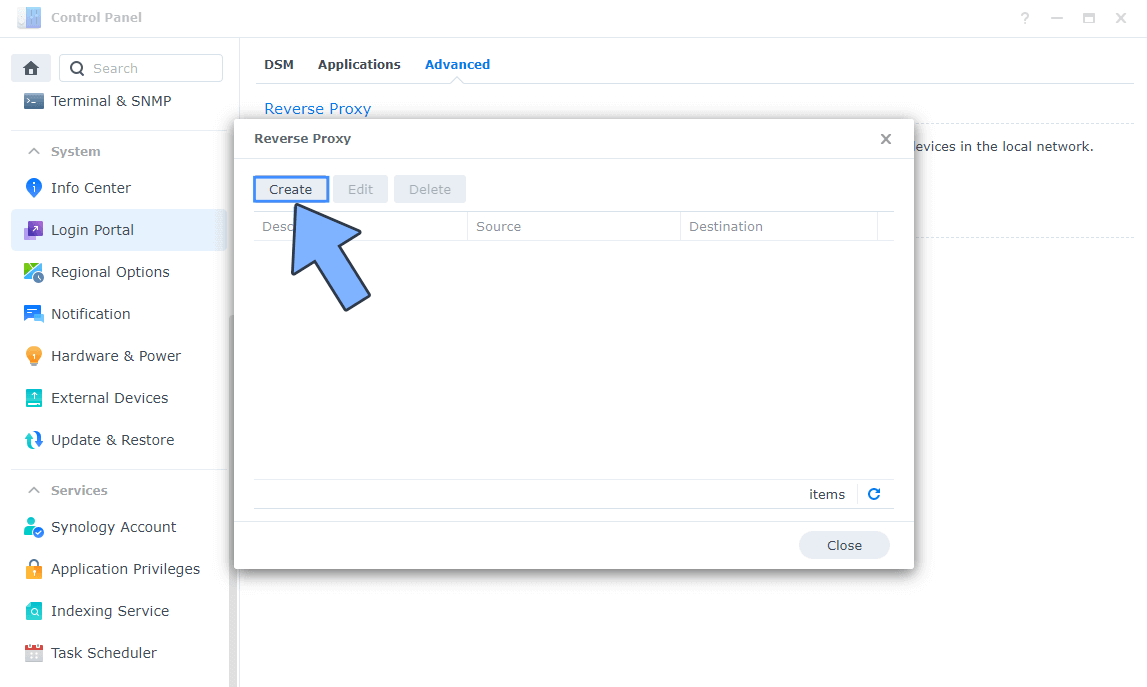
STEP 12
After you click the Create button, the window below will open. Follow the instructions in the image below.
On the General area, set the Reverse Proxy Name description: type in OnlyOffice. After that, add the following instructions:
Source:
Protocol: HTTPS
Hostname: onlyoffice.yourname.synology.me
Port: 443
Check Enable HSTS
Destination:
Protocol: HTTP
Hostname: localhost
Port: 8467
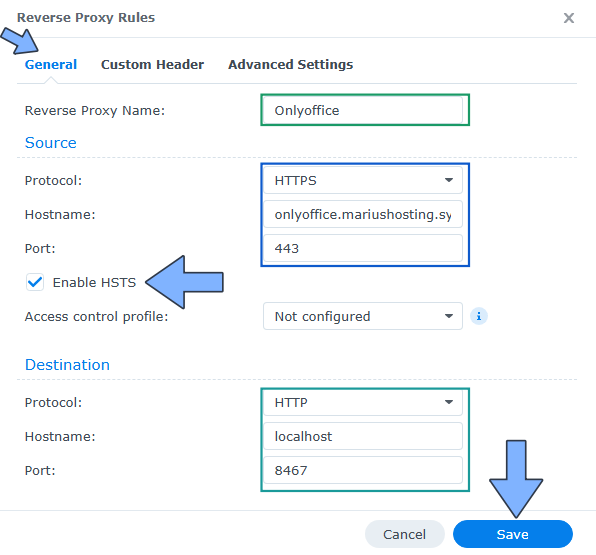
STEP 13
Go to File Station and open the docker folder. Inside the docker folder, create one new folder and name it syncin. Follow the instructions in the image below.
Note: Be careful to enter only lowercase, not uppercase letters.
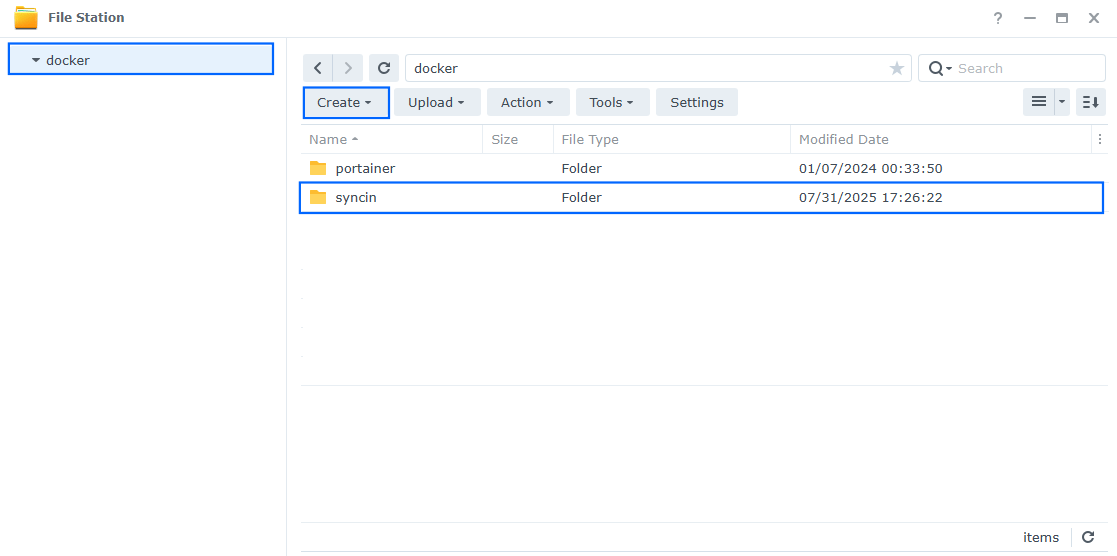
STEP 14
Now create four new folders inside the syncin folder that you have previously created at STEP 13, and name them data, db, onlyoffice, static. Follow the instructions in the image below.
Note: Be careful to enter only lowercase, not uppercase letters.
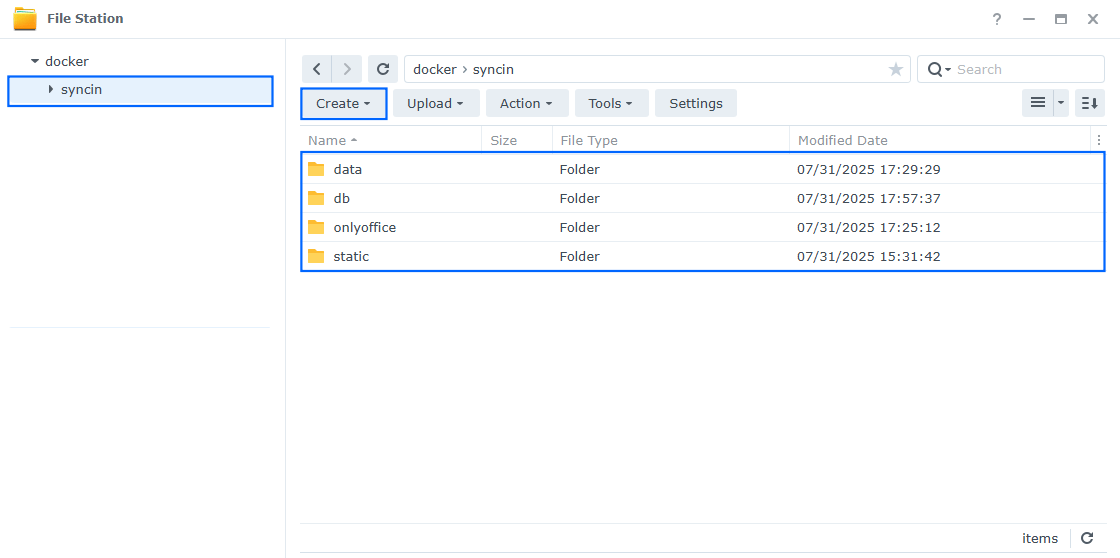
STEP 15
Now create seven new folders inside the syncin folder that you have previously created at STEP 13, and name them data, database, fonts, lib, logs, rabbitmq, redis . Follow the instructions in the image below.
Note: Be careful to enter only lowercase, not uppercase letters.
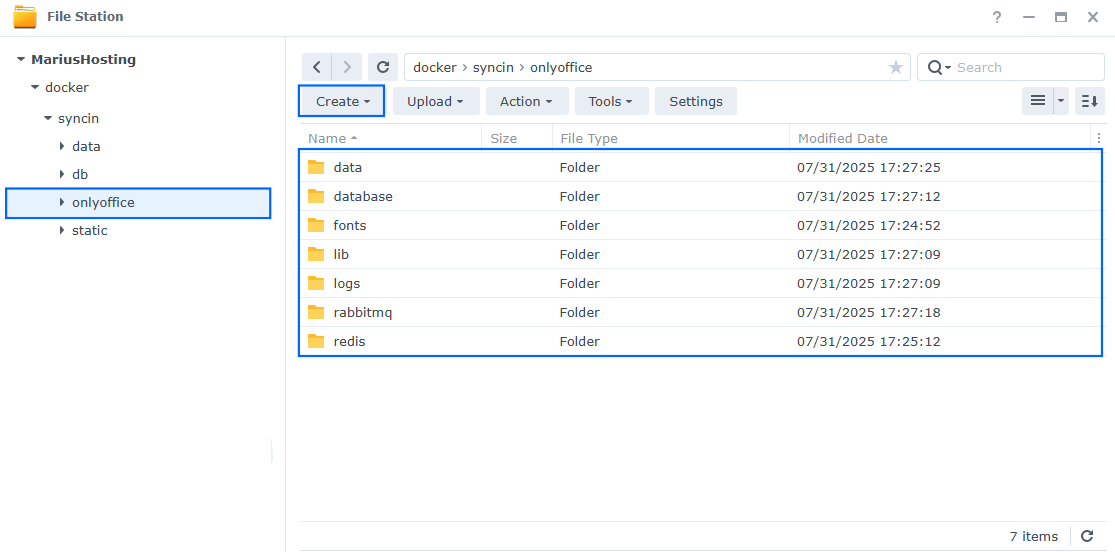
STEP 16
Download (click on the blue link below) and upload the environment.yaml file below in the syncin folder that you have previously created at STEP 13. Follow the instructions in the image below. 🔒Note: Support my work to unlock the password. You can use this password to download any file on mariushosting forever!
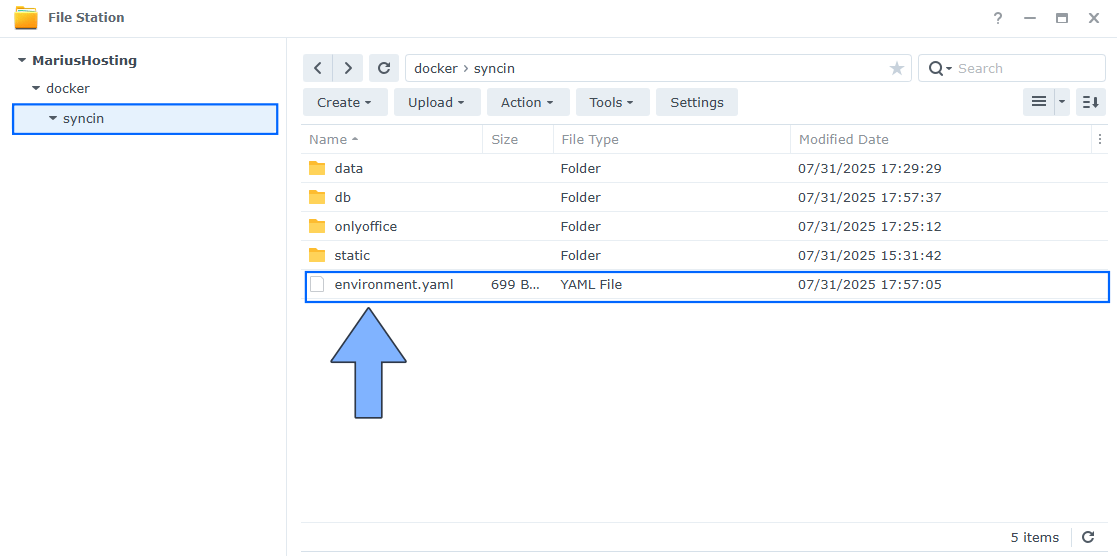
STEP 17
Make sure you have installed Text Editor on your Synology NAS as per the instructions at STEP 3. Double click on the environment.yaml file to edit it. Change the following 2 secret parameters:
access
secret: (Generate your own FREE Random 64 length SECRET KEY.)
refresh
secret: (Generate your own FREE Random 64 length SECRET KEY.)
Both parameters should be different. Click X to save the file. Follow the instructions in the image below. Go straight to the next STEP.
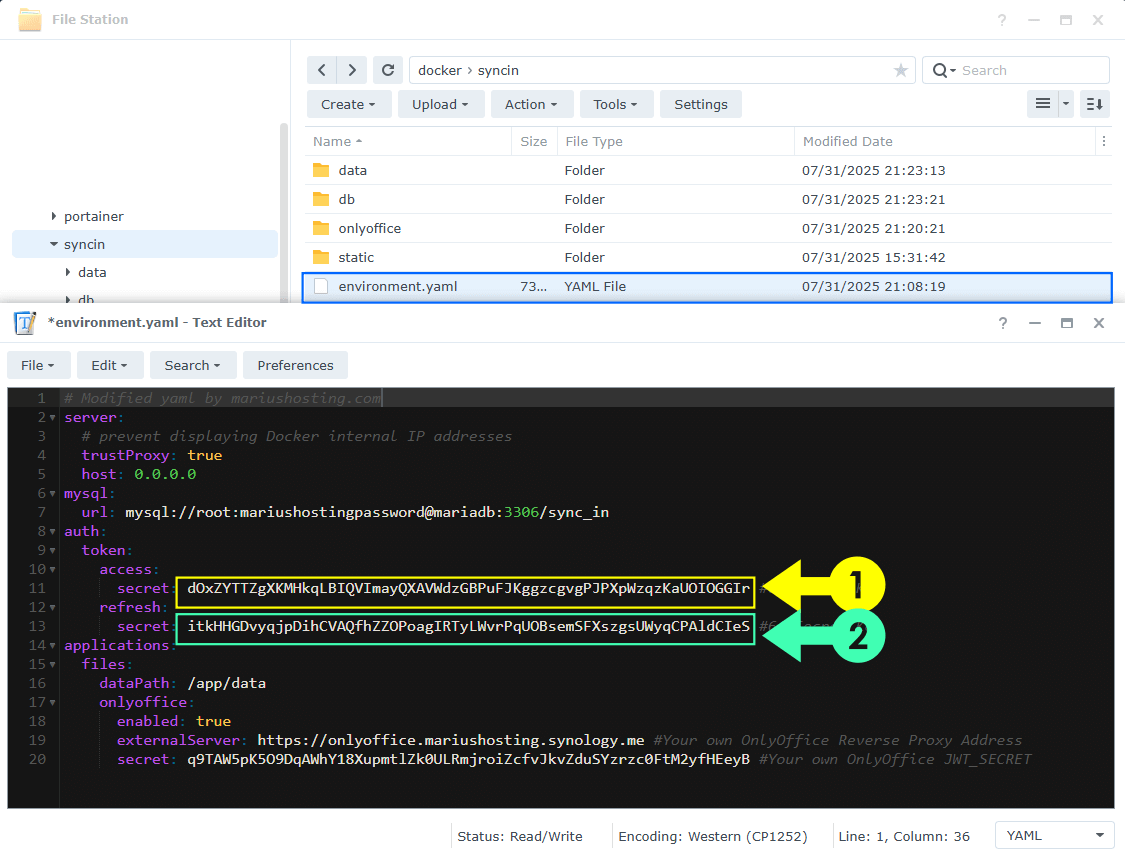
STEP 18
Log into Portainer using your username and password. On the left sidebar in Portainer, click on Home then Live connect. Follow the instructions in the image below.
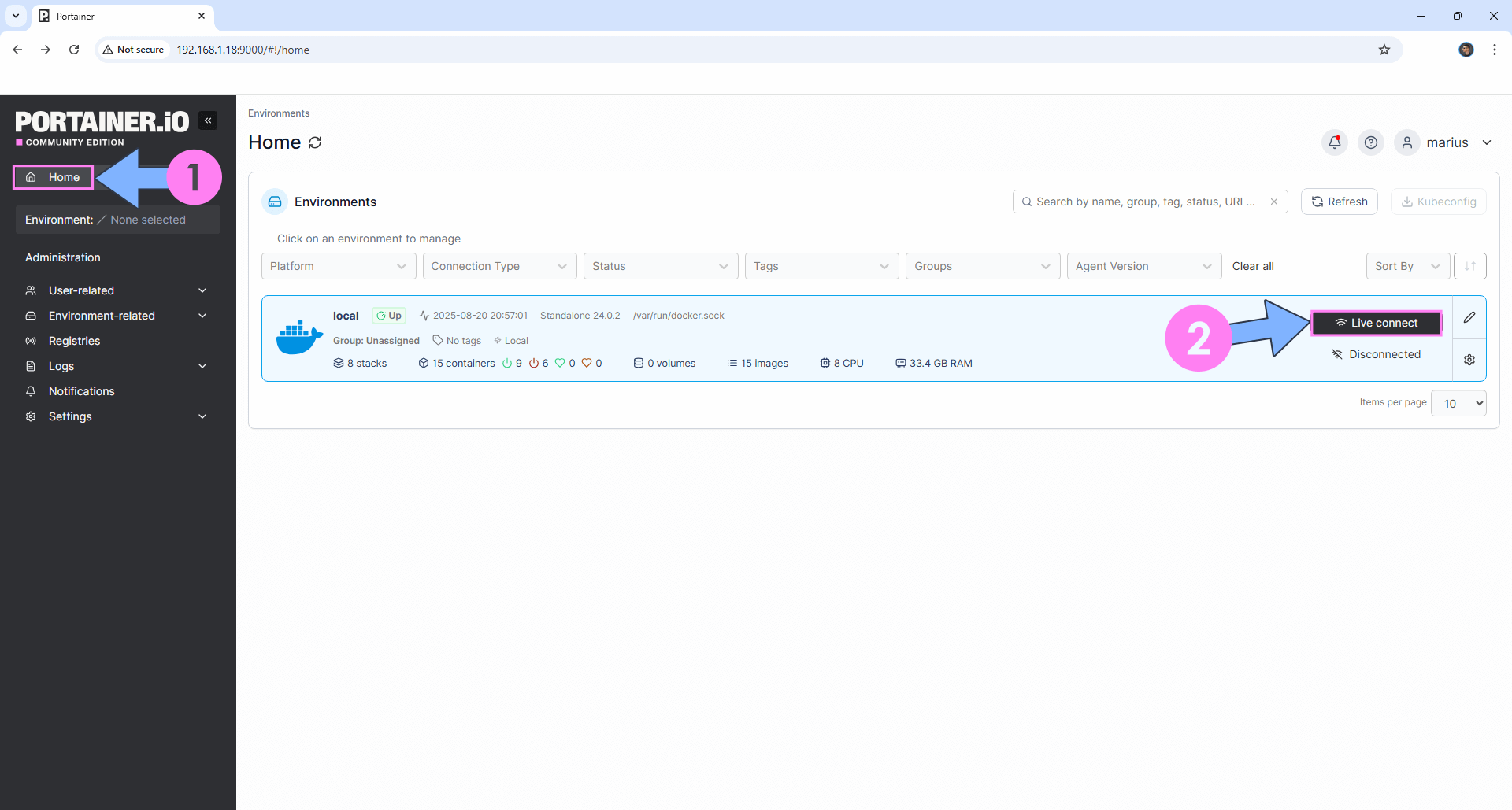
On the left sidebar in Portainer, click on Stacks then + Add stack. Follow the instructions in the image below.
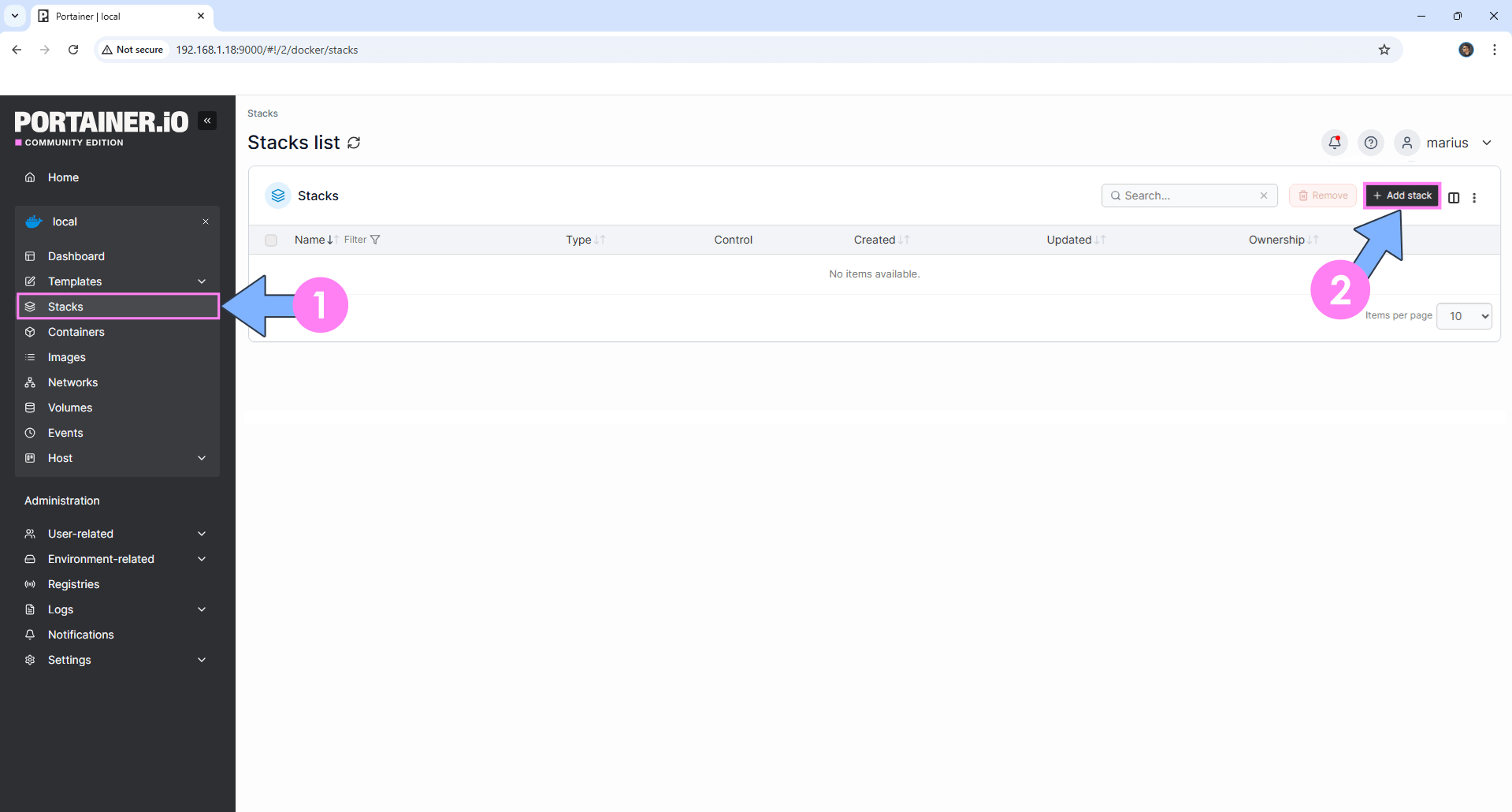
STEP 19
In the Name field type in syncin. Follow the instructions in the image below.
services:
sync_in:
image: syncin/server:latest
container_name: Sync-in
healthcheck:
test: ["CMD-SHELL", "nc -z 127.0.0.1 8080 || exit 1"]
interval: 10s
timeout: 5s
retries: 3
start_period: 90s
environment:
INIT_ADMIN_LOGIN: marius
INIT_ADMIN_PASSWORD: mariushosting
PUID: 1026
PGID: 100
ports:
- 8324:8080
volumes:
- /volume1/docker/syncin/environment.yaml:/app/environment/environment.yaml
- /volume1/docker/syncin/data:/app/data:rw
- /volume1/docker/syncin/static:/app/static/releases:ro
logging:
driver: json-file
options:
max-size: "25m"
max-file: "5"
depends_on:
- mariadb
- onlyoffice
restart: on-failure:10
mariadb:
image: mariadb:11.4-noble #LTS Long Time Support Until May 29, 2029.
container_name: Sync-in-DB
security_opt:
- no-new-privileges:false
command: --innodb_ft_cache_size=16000000 --max-allowed-packet=1G
environment:
MYSQL_DATABASE: sync_in
MYSQL_ROOT_PASSWORD: mariushostingpassword
TZ: Europe/Bucharest
volumes:
- /volume1/docker/syncin/db:/var/lib/mysql:rw
restart: on-failure:5
onlyoffice:
container_name: Sync-in-ONLYOFFICE
hostname: onlyoffice
image: onlyoffice/documentserver:latest
healthcheck:
test: timeout 10s bash -c ':> /dev/tcp/127.0.0.1/80' || exit 1
interval: 10s
timeout: 5s
retries: 3
start_period: 90s
ports:
- 8467:80
environment:
JWT_ENABLED: true
JWT_SECRET: q9TAW5pK5O9DqAWhY18XupmtlZk0ULRmjroiZcfvJkvZduSYzrzc0FtM2yfHEeyB
volumes:
- /volume1/docker/syncin/onlyoffice/logs:/var/log/onlyoffice:rw
- /volume1/docker/syncin/onlyoffice/data:/var/www/onlyoffice/Data:rw
- /volume1/docker/syncin/onlyoffice/redis:/var/lib/redis:rw
- /volume1/docker/syncin/onlyoffice/rabbitmq:/var/lib/rabbitmq:rw
- /volume1/docker/syncin/onlyoffice/lib:/var/lib/onlyoffice:rw
- /volume1/docker/syncin/onlyoffice/fonts:/usr/share/fonts/truetype/custom:rw
- /volume1/docker/syncin/onlyoffice/database:/var/lib/postgresql:rw
restart: on-failure:5
Note: Before you paste the code above in the Web editor area below, change the value for INIT_ADMIN_LOGIN. Type in your own username. marius is an example for a username.
Note: Before you paste the code above in the Web editor area below, change the value for INIT_ADMIN_PASSWORD. Type in your own password. mariushosting is an example for a password.
Note: Before you paste the code above in the Web editor area below, change the value numbers for PUID and PGID with your own values. (Follow my step by step guide on how to do this.)
Note: Before you paste the code above in the Web editor area below, change the value for MYSQL_ROOT_PASSWORD. Type in your own password. mariushostingpassword is an example for a password. ⚠️WARNING: Make sure you have installed Text Editor on your Synology NAS as per the instructions at STEP 3. Double click on the environment.yaml file that you have previously uploaded at STEP 16. Change the password with your own password in the environment.yaml file with the same identical password that you have added in the MYSQL_ROOT_PASSWORD area. 🖼️Check the EXAMPLE screenshot. Save the file.
Note: Before you paste the code above in the Web editor area below, change the value for TZ. (Select your current Time Zone from this list.)
Note: Before you paste the code above in the Web editor area below, change the value for JWT_SECRET. (Generate your own Random 64 length JWT_SECRET.)
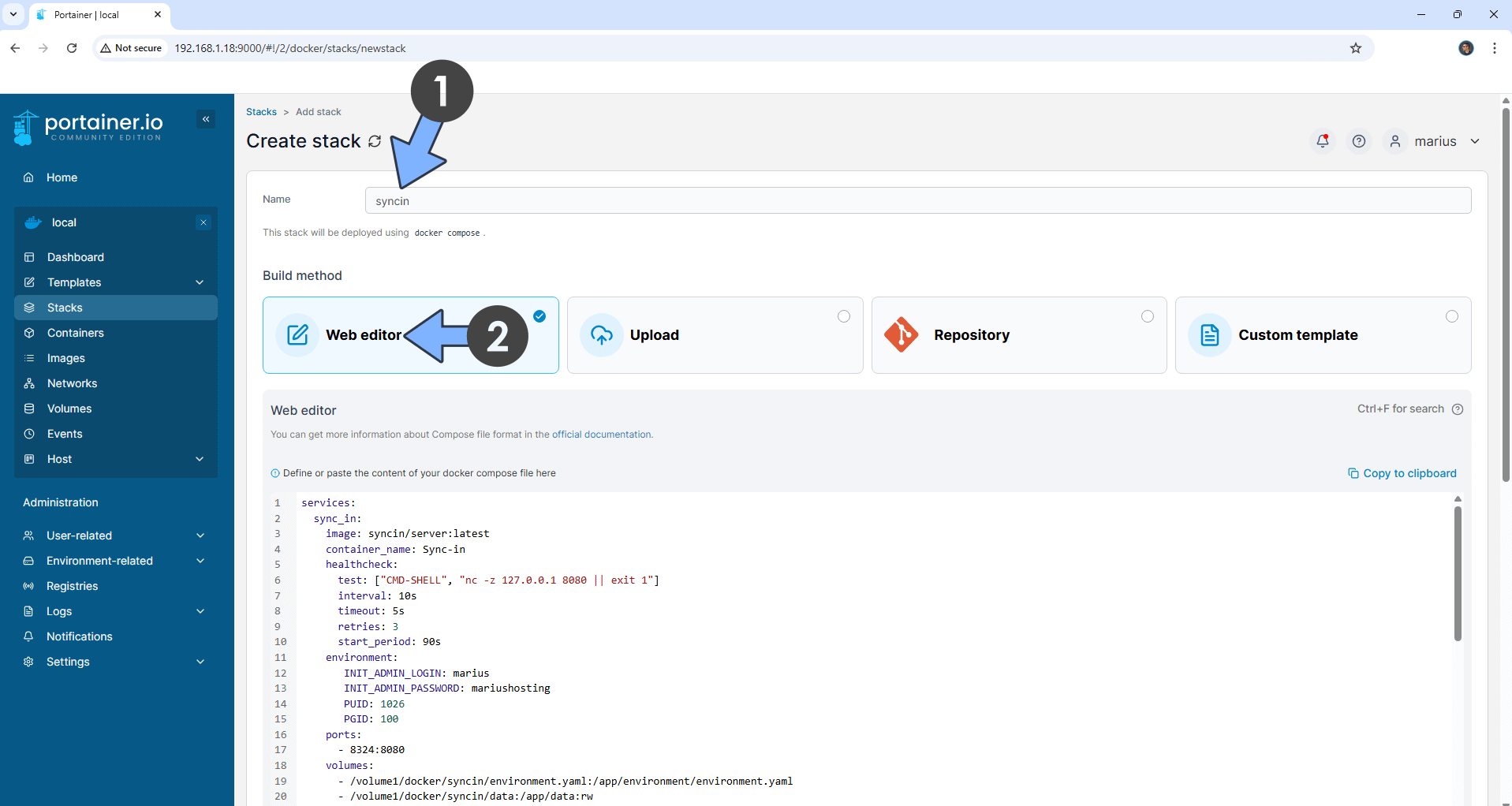
STEP 20
Scroll down on the page until you see a button named Deploy the stack. Click on it. Follow the instructions in the image below. The installation process can take up to a few minutes. It will depend on your Internet speed connection.
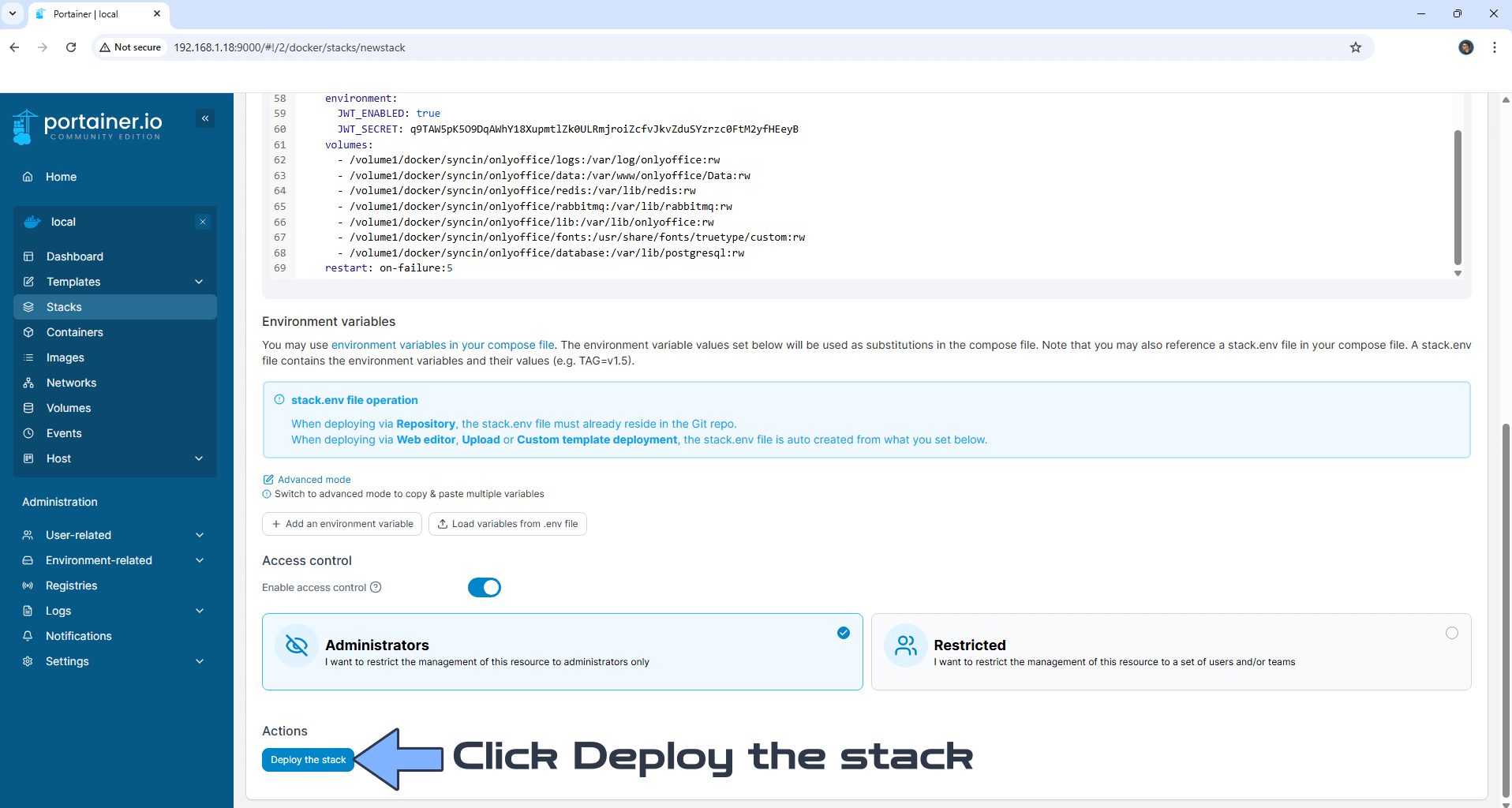
STEP 21
If everything goes right, you will see the following message at the top right of your screen: “Success Stack successfully deployed“.
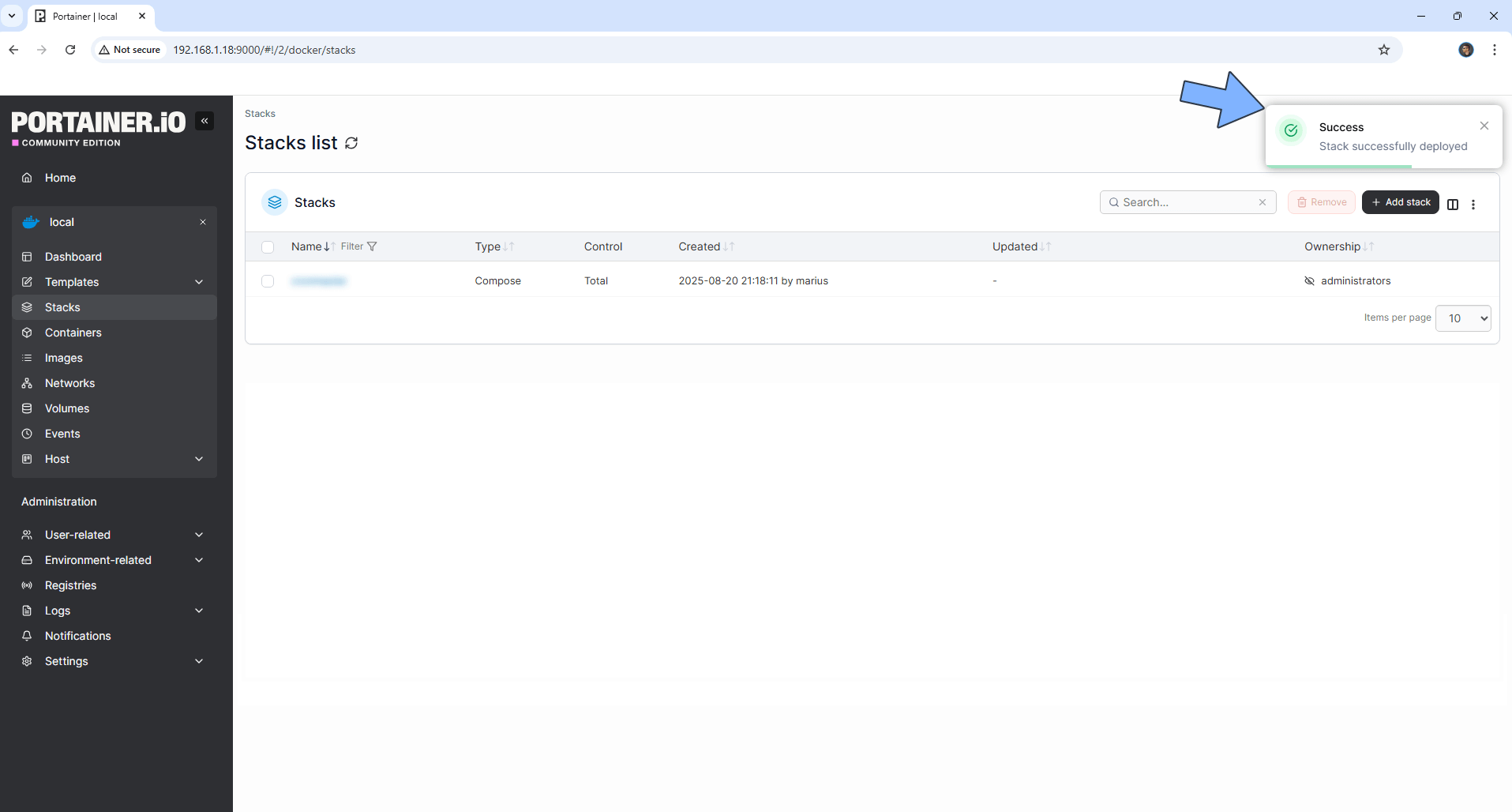
STEP 22
Make sure you have installed Text Editor on your Synology NAS as per the instructions at STEP 3. Double click on the environment.yaml file to edit it. Change the externalServer parameter.
Type in your own synology.me DDNS with https:// at the beginning that you have previously created at STEP 12. Click X to save the file. Follow the instructions in the image below. Go straight to the next STEP.
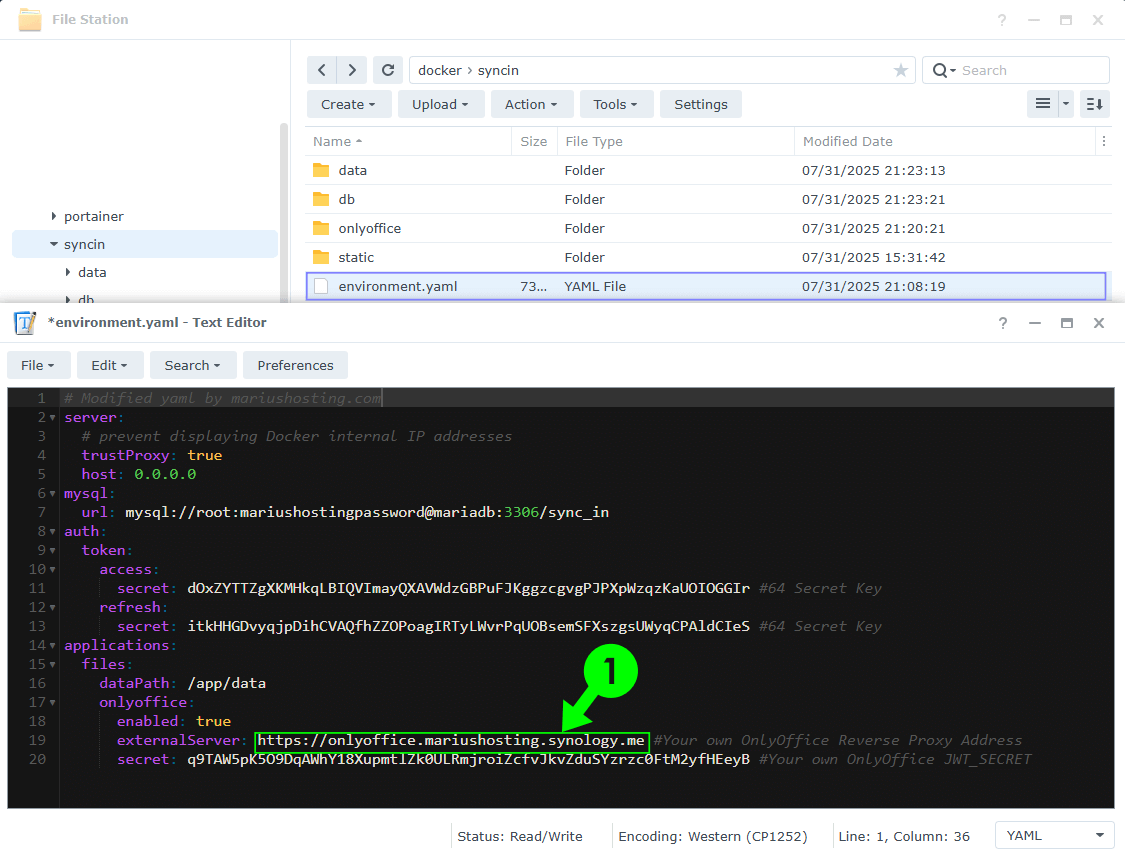
STEP 23
Make sure you have installed Text Editor on your Synology NAS as per the instructions at STEP 3. Double click on the environment.yaml file to edit it. Change the secret parameter.
Type in your own OnlyOffice JWT_SECRET that you have previously added at STEP 19. Click X to save the file. Follow the instructions in the image below. Go straight to the next STEP.
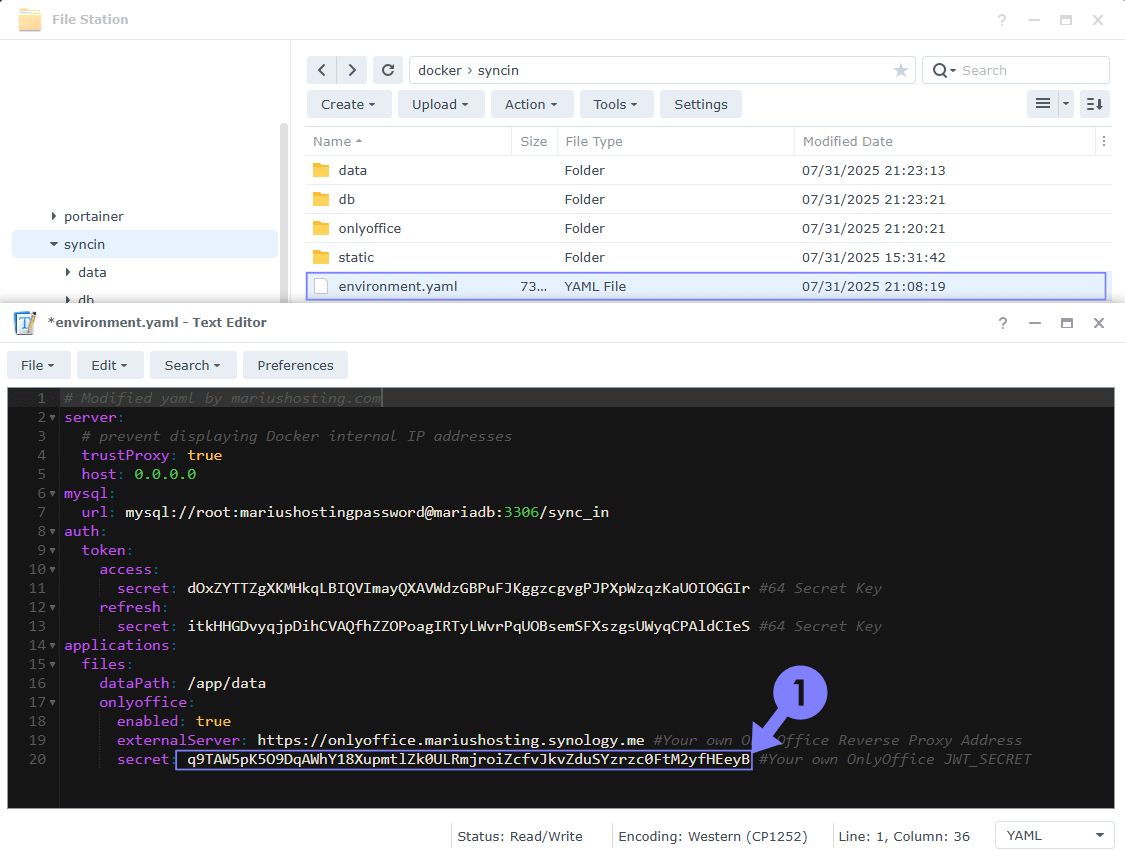
STEP 24
Open Portainer. On the left sidebar, click Containers. Select your Sync-in and Sync-in-DB instance, then click Restart. Follow the instructions in the image below.
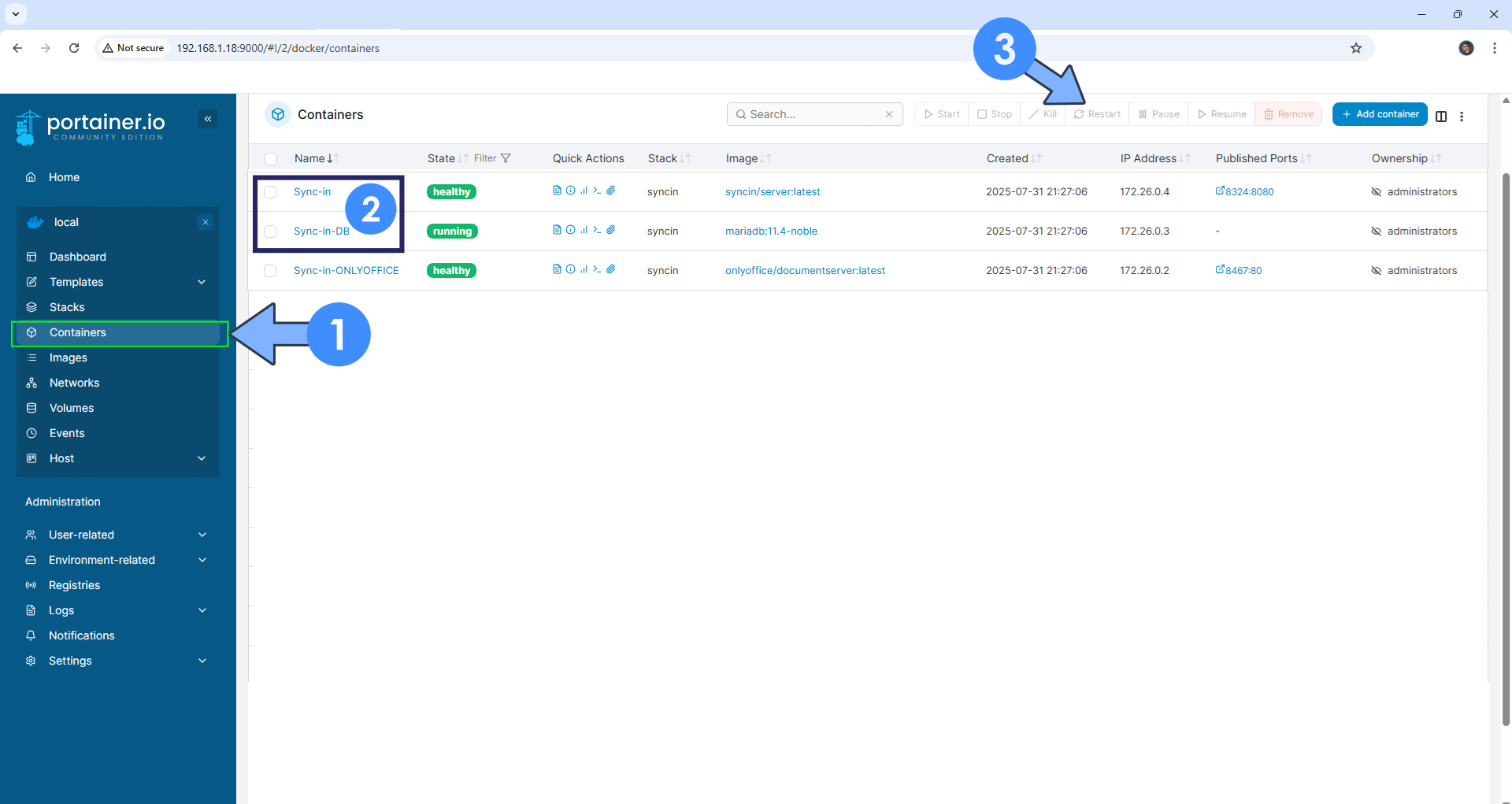
STEP 25
🟢Please Support My work by Making a Donation. Almost 99,9% of the people that install something using my guides forget to support my work, or just ignore STEP 1. I’ve been very honest about this aspect of my work since the beginning: I don’t run any ADS, I don’t require subscriptions, paid or otherwise, I don’t collect IPs, emails, and I don’t have any referral links from Amazon or other merchants. I also don’t have any POP-UPs or COOKIES. I have repeatedly been told over the years how much I have contributed to the community. It’s something I love doing and have been honest about my passion since the beginning. But I also Need The Community to Support me Back to be able to continue doing this work.
STEP 26
Please wait approximately 5 minutes or you will get a blank synology error page if you try to connect too soon. Now open your browser and type in your HTTPS address that you have previously added at STEP 9 with https:// at the beginning like this https://syncin.yourname.synology.me In my case it’s https://syncin.mariushosting.synology.me If everything goes right, you will see the Sync-in Sign in page. Type in your own Username (INIT_ADMIN_LOGIN) and Password (INIT_ADMIN_PASSWORD) that you have previously added at STEP 19. Click Sign in. Follow the instructions in the image below.
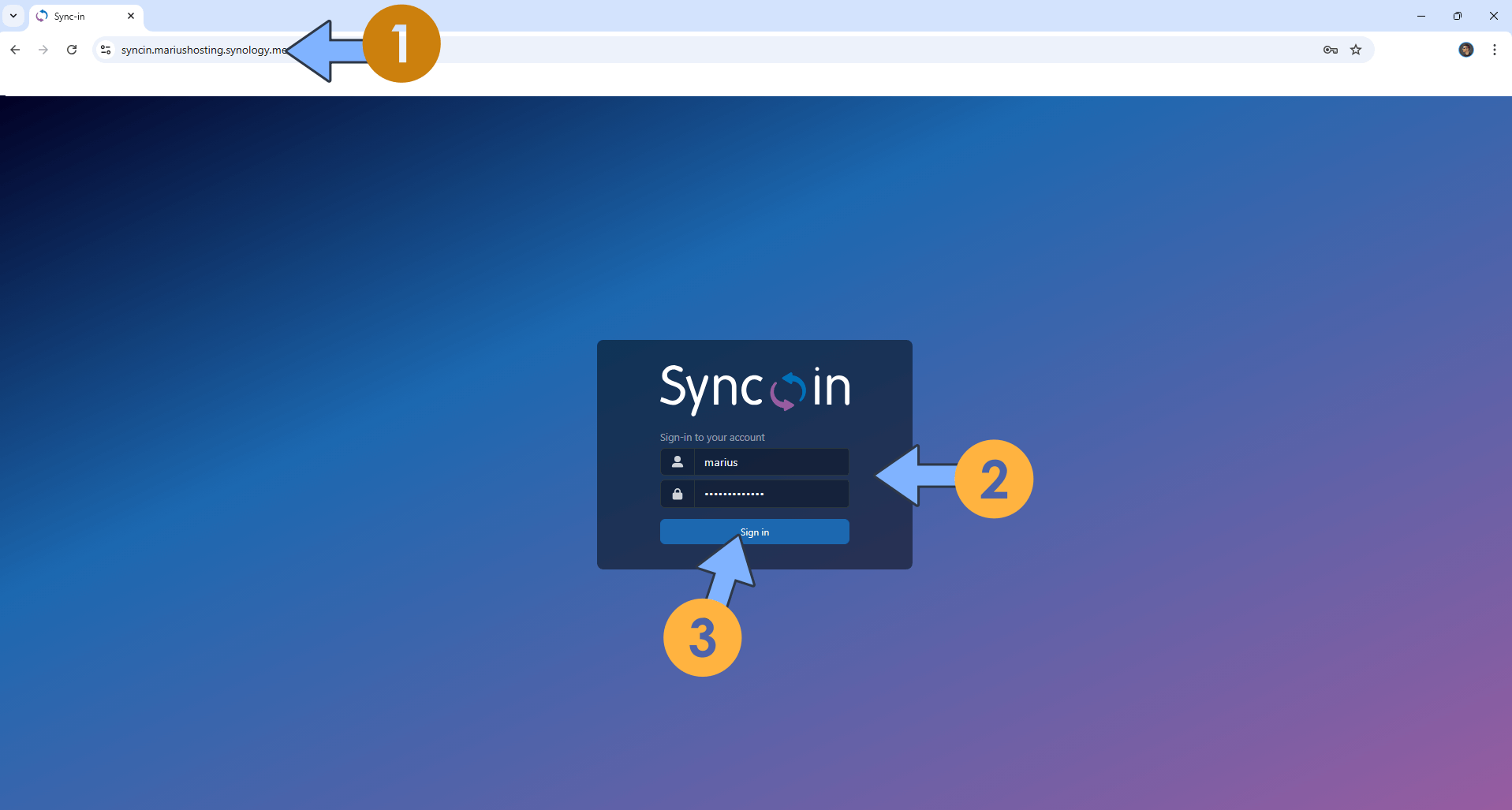
STEP 27
At the top right of the page, click on the user icon then switch the theme to Dark by clicking the switch icon. Click the Settings icon. Follow the instructions in the image below.
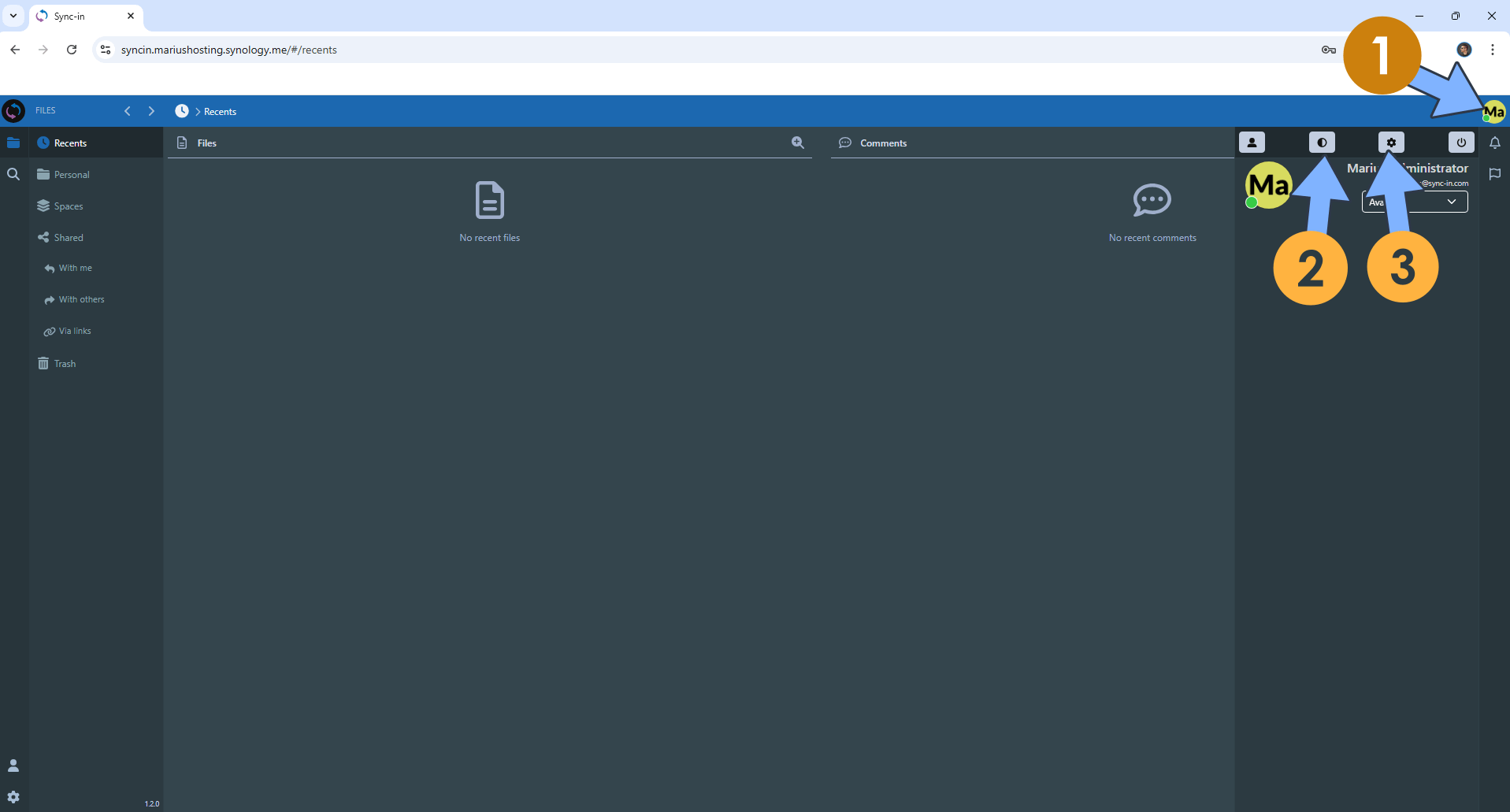
STEP 28
By clicking the Account tab you can update and save your account information. Click Confirm to save the settings. Follow the instructions in the image below.
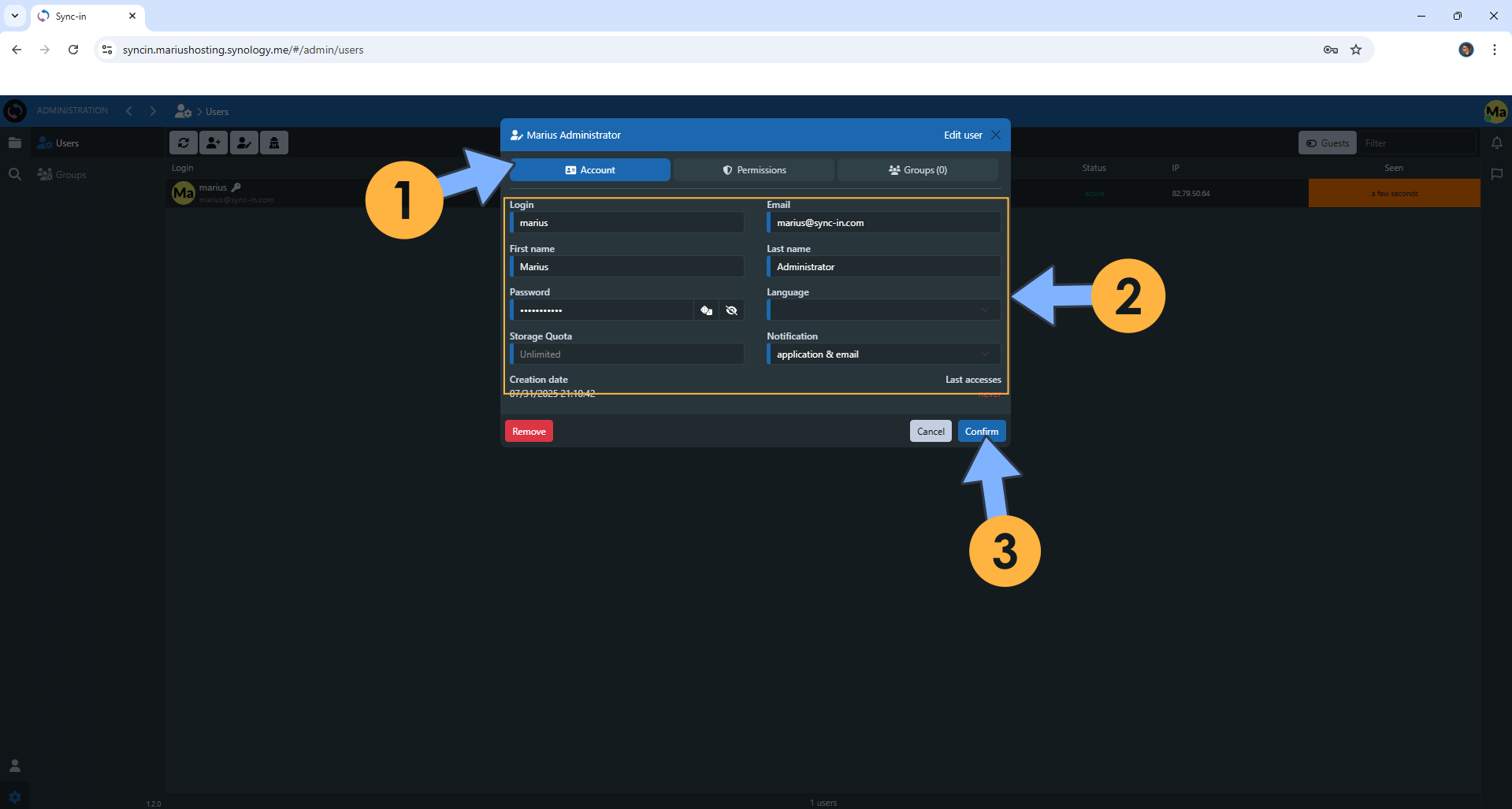
STEP 29
On the Permissions tab, you should give all the Permissions to your administrator user. Click Confirm to save the settings. Follow the instructions in the image below.
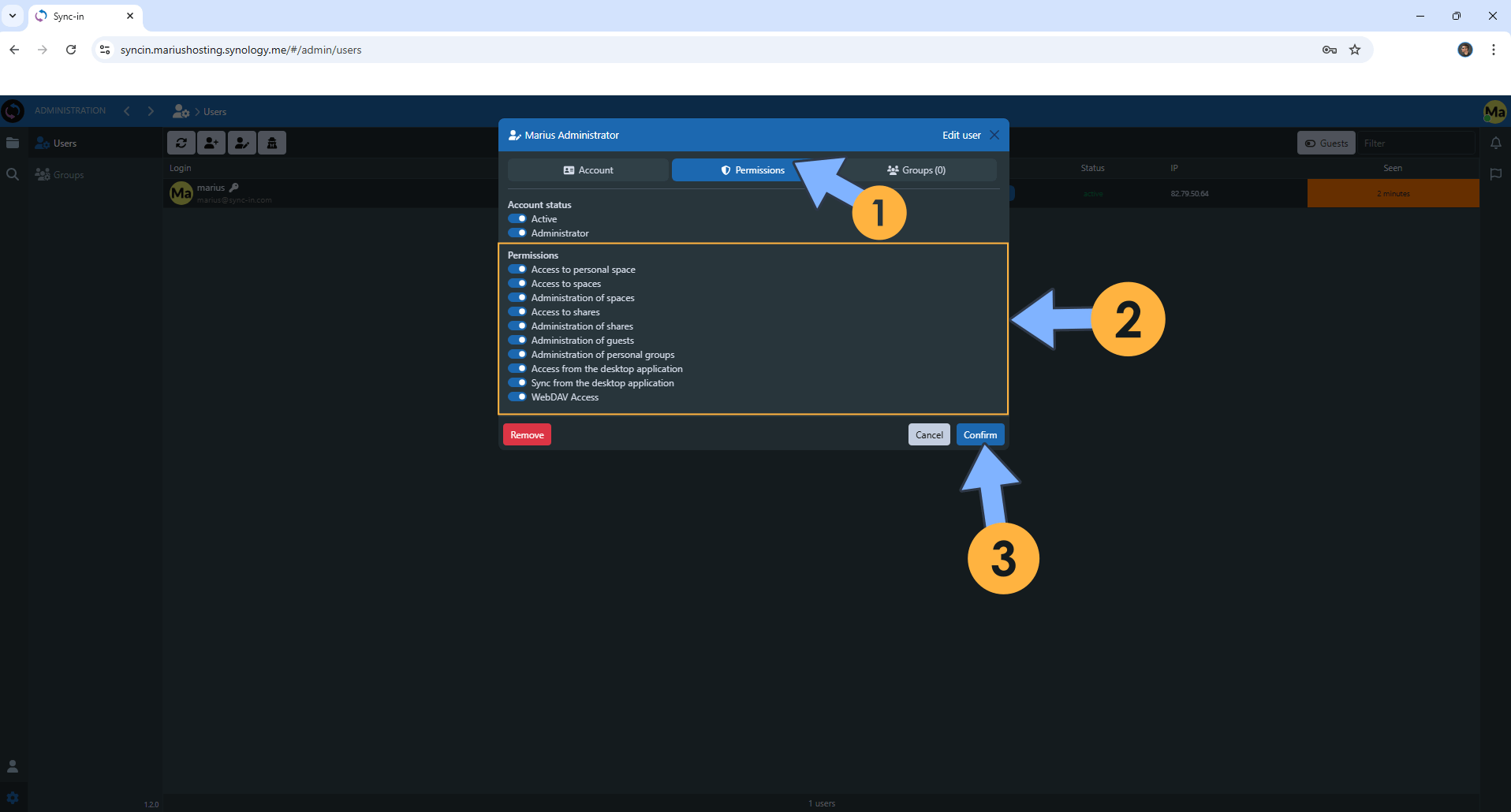
STEP 30
On the left sidebar, you can click the + icon to upload your files or create new documents. Follow the instructions in the image below.
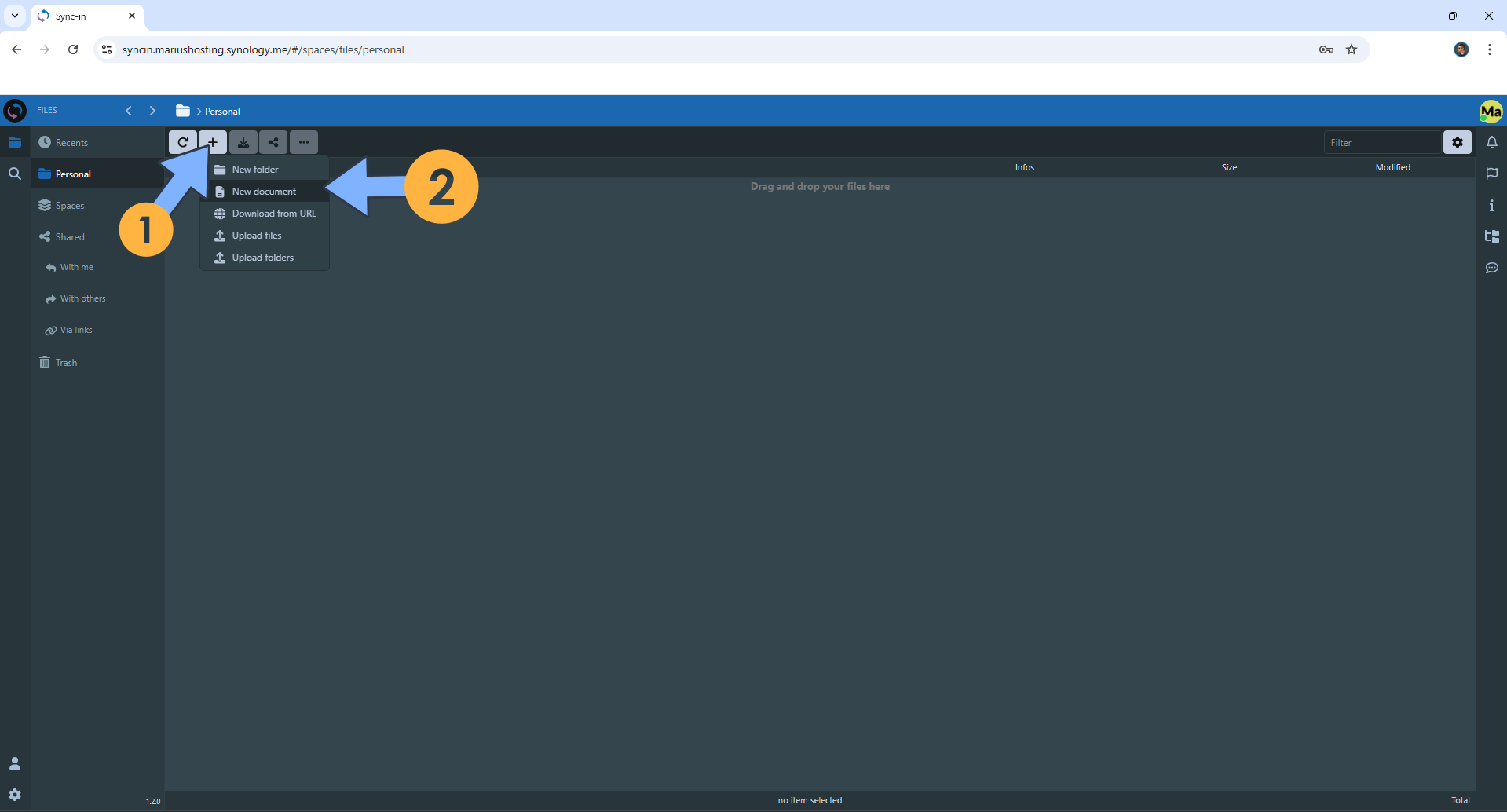
STEP 31
Select the document type. Give a name to the Document. Click Confirm. Follow the instructions in the image below.
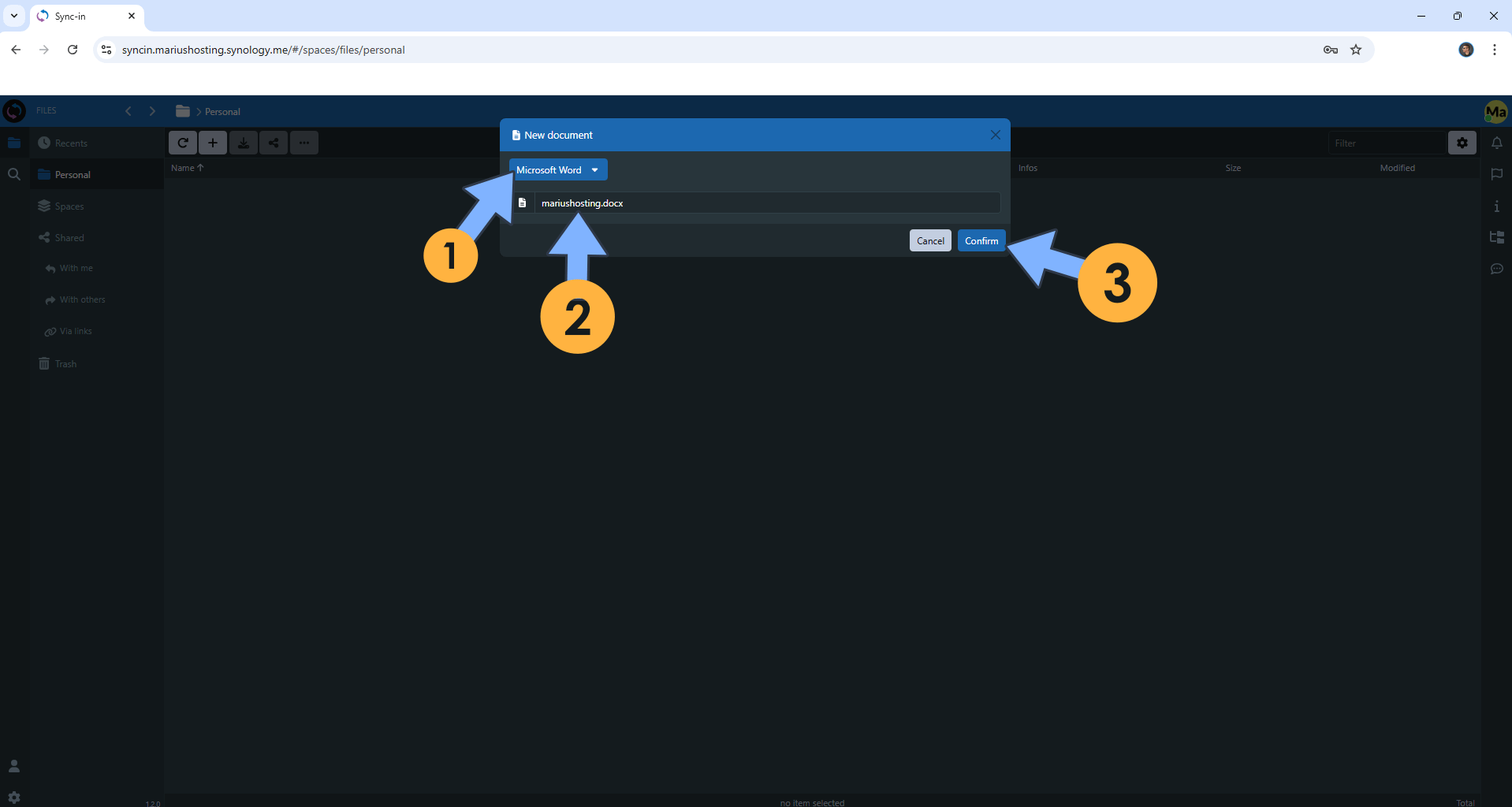
STEP 32
Select your Document. Right mouse click then Edit. Follow the instructions in the image below. ⚠️Warning: If you don’t click Edit, you won’t be able to modify/edit any document. Clicking “Edit” is mandatory if you want to modify/edit documents.
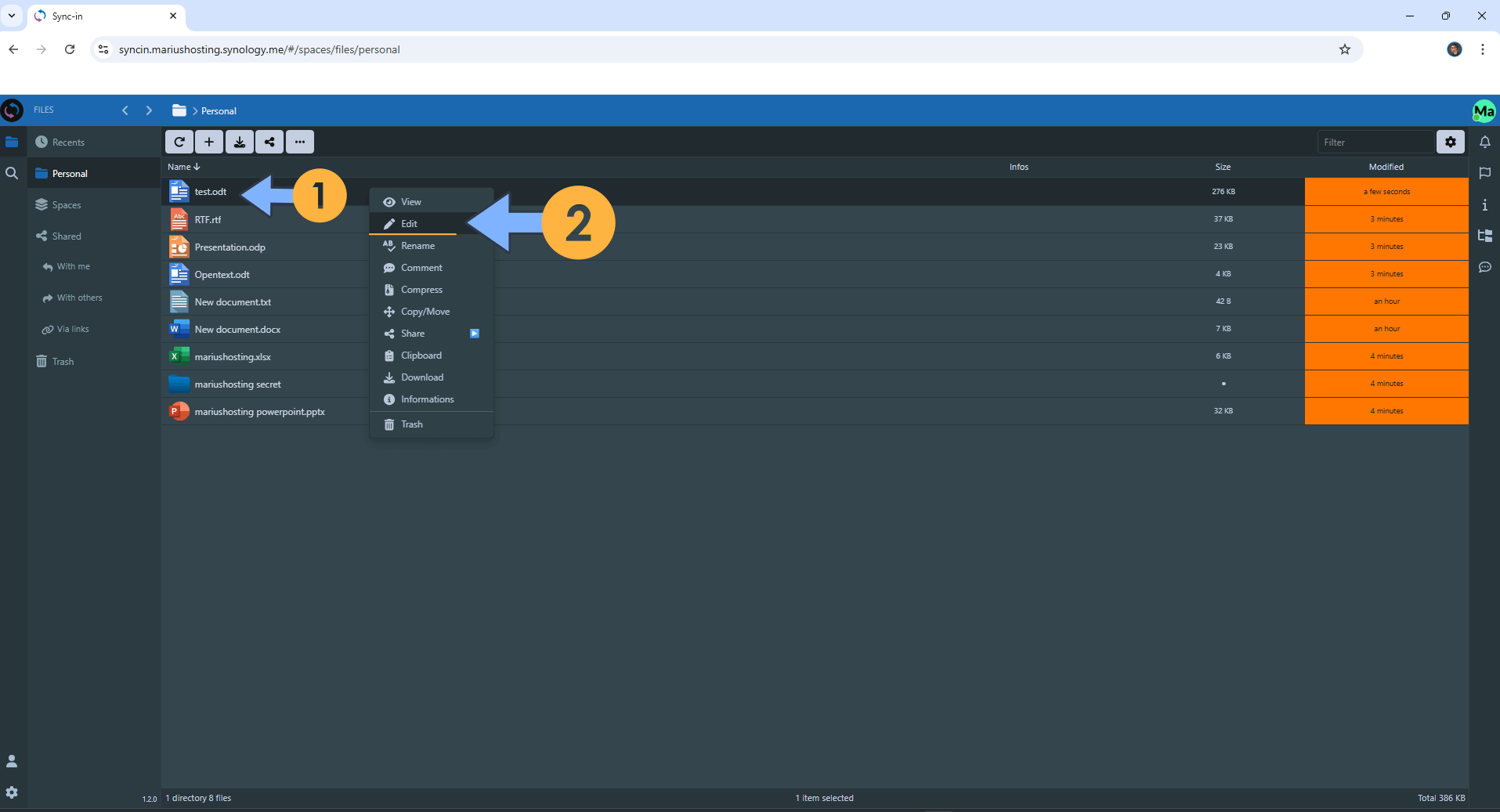
STEP 33
You can use your integrated OnlyOffice to view and modify (Edit) your documents.
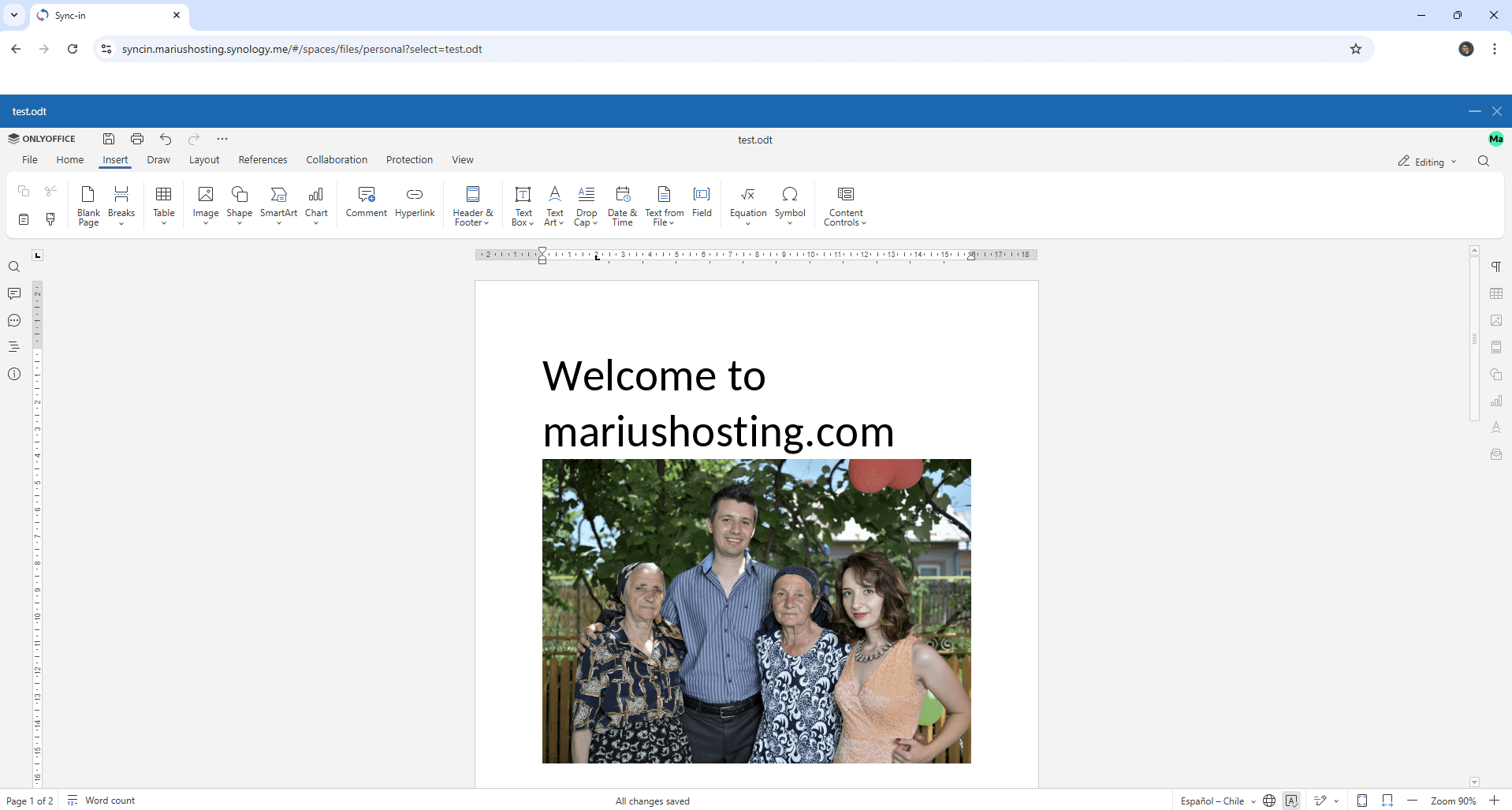
Enjoy Sync-in!
⚠️Note If you encounter issues by using this container, make sure to check out the Common Docker issues article. ⚠️Check out the Sync-in Full Documentation.
⚠️Note If you encounter issues to create the admin user in the database, just add at STEP 19 the following environment variable INIT_ADMIN: true after INIT_ADMIN_LOGIN: marius then update the stack in Portainer.
Note: Can I run Docker on my Synology NAS? See the supported models.
Note: How to Back Up Docker Containers on your Synology NAS.
Note: Find out how to update the Sync-in container with the latest image.
Note: How to Add USB Support on DSM 7.2.
Note: How to Free Disk Space on Your NAS if You Run Docker.
Note: How to Schedule Start & Stop For Docker Containers.
Note: How to Activate Email Notifications.
Note: How to Add Access Control Profile on Your NAS.
Note: How to Change Docker Containers Restart Policy.
Note: How to Use Docker Containers With VPN.
Note: Convert Docker Run Into Docker Compose.
Note: How to Clean Docker.
Note: How to Clean Docker Automatically.
Note: Best Practices When Using Docker and DDNS.
Note: Some Docker Containers Need WebSocket.
Note: Find out the Best NAS Models For Docker.
Note: Activate Gmail SMTP For Docker Containers.
This post was updated on Saturday / November 22nd, 2025 at 2:01 PM
